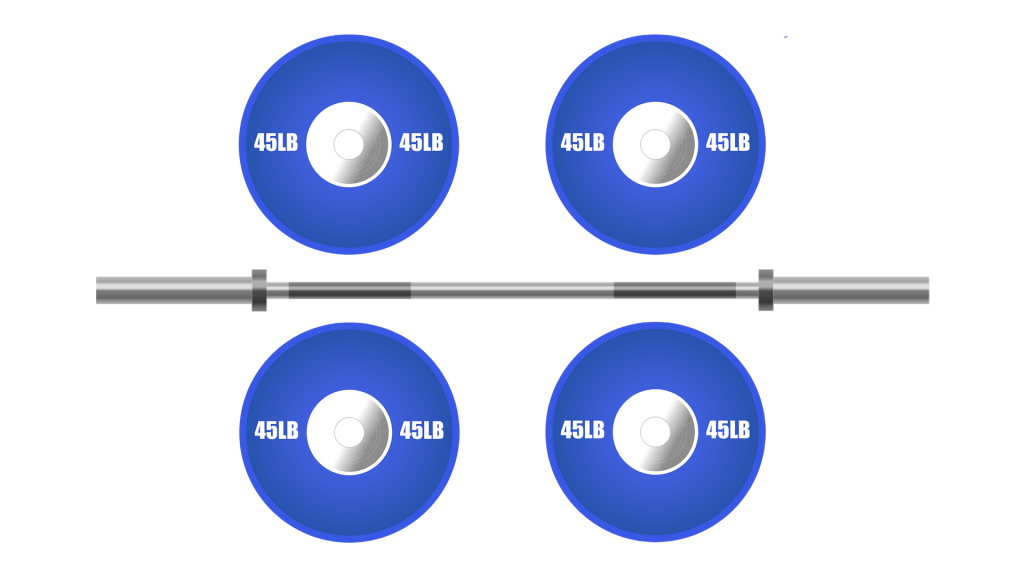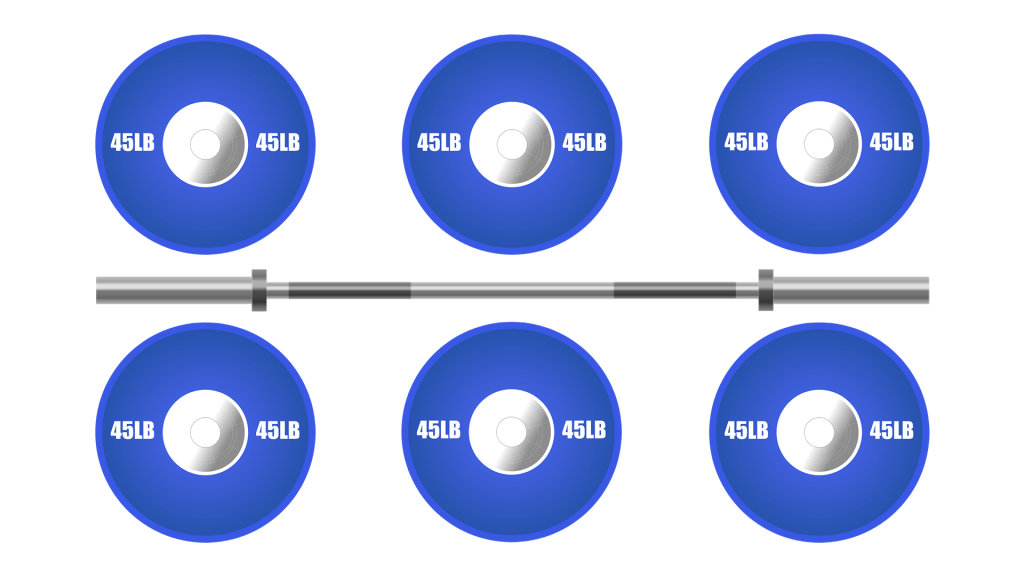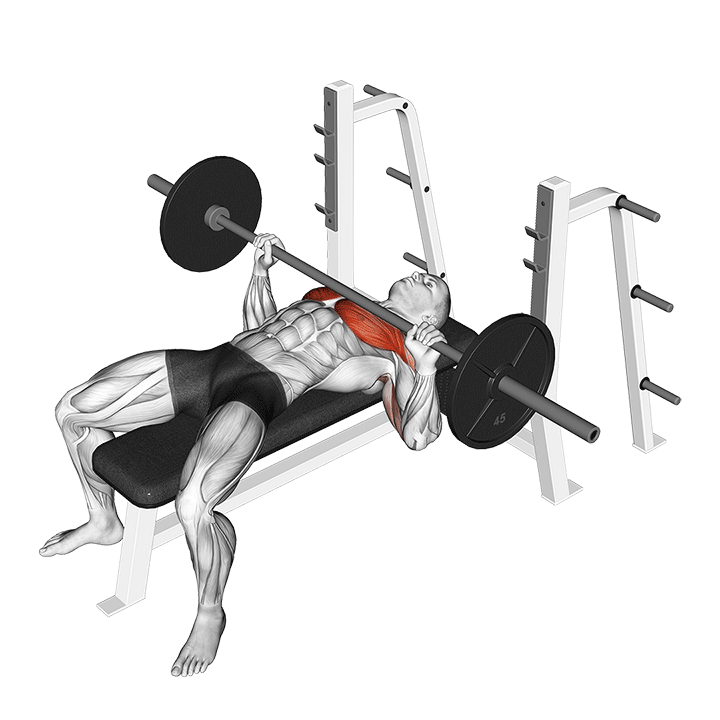How Many Reps of 225 to Bench 315: Formulas and Table
The very idea of benching 225 pounds - practically a fully grown male - is considered to be an impressive achievement in and of itself.
But what about the next milestone, the “3 plate bench”, or what is otherwise known as “benching 315”?
Whether it be to estimate your rate of progression or to see if you actually can press 315 pounds, it’s a good idea to get a rough estimate of how many repetitions of 225 pounds equates to a single bench press repetition of 315 pounds.
Without going too deep into the subject matter, it can be said that roughly 12 repetitions of 225 pounds will equate to a one-repetition maximum of 315 pounds when using the popular Epley formula. Of course, this is only a guess, and different formulas and other factors may return a different number.
What is Benching 225 - And is it a Good Bench?
The term “benching” refers to the conventional barbell bench press - where a lifter will lower a loaded barbell to their chest as they lie on an exercise bench, before pressing it back up.
As such, “benching 225” refers to a lifter doing so with 225 pounds or 102 kilograms of weight.

Bench pressing 225 pounds or 102 kilograms is often considered to be a weightlifting milestone due to the fact that it equates to two pairs of 45 pound or 20 kilogram plates being loaded onto a standard barbell.
By nearly every metric, being able to perform a 225 pound bench press for multiple repetitions is considered to be a “good” bench in terms of comparative statistics.
Is a 315 Pound Bench Good?
In relation, a bench press of 315 pounds or 143 kilograms is considered to be the next major milestone after a 225 pound bench, as it involves three pairs of 45 pound plates, rather than two pairs.

When looking at clinical studies, one can get a sense of just how few lifters are actually capable of performing a bench press with 315 pounds. It takes a considerable amount of effort, planning and a small amount of genetic luck to do so - hence the fact that a 315 pound bench press is considered to be an impressive feat among weightlifters.
For context; in an untrained and general sample size, the average man is only capable of a single 135 pound bench press repetition, and approximately half that for the average woman.
Formulas for Estimating Bench Press 1RM
Apart from actually testing it out yourself, one way of finding out how many repetitions of 225 pounds equates to 315 pounds is to calculate it - either by doing the math or inputting your stats into a 1RM calculator.
Over the years, numerous different formulas have been developed in the hopes of accurately estimating how many repetitions of X weight equates to a one-rep max of a heavier weight. All differ in terms of purpose and method of calculation, but the most popular are the Brzycki and Epley formulas.
It should be noted that these formulas are not always completely accurate, and variability in terms of physiology, environmental factors and even mathematical inaccuracies can return a number that does not reflect the lifter’s actual physical capabilities.
In truth, for bench press the Wathan or Mayhew et al. formulas are far more accurate for the bench press. Using the Mayhew et al. formula, estimates roughly 14 reps of 225 for 314 and the Wathan formula similarly is roughly 11 or 12 reps of 225.
Calculating a 315 Pound Bench Press
Note: The formulas below require you to plug and chug your values. If you're interested in having this math done for you, use our bench press calculator.
With the Epley Formula
The Epley formula utilizes repetitions and weight lifted per repetition in order to calculate a one-repetition maximum, as is showcased with the formula: [1RM = (Weight lifted) * (1 + (0.0333 x Repetitions))].
First, we must rearrange the formula so as to make the equation result in repetitions, rather than a 1RM. This creates the formula: [Repetitions = (1RM / Weight lifted - 1) / 0.0333].
Inputting 315 as the value for “1RM” and 225 for “Weight lifted”, the calculation will return a sum of 12.01 - meaning that 12.01 repetitions of 225 corresponds to a 1RM of 315 pounds.
With the Brzycki Formula
Just like with the Epley formula, the Brzycki formula is both relatively simplistic in calculation and requires only two inputs from the lifter in order to be used correctly.
However, some rearranging of the formula will be needed, as it was not originally designed to estimate volume.
Rather than utilizing the original Brzycki formula [1RM = (Weight lifted) / (1.0278 - (0.0278 x Repetitions))], it will be shaped to show [Repetitions = (1.0278 - (Weight lifted) / 1RM) / 0.0278].
Inputting 315 as the value within the latter end of the parentheses and 225 in the former end, the calculation will return an output of [Repetitions = 11.27], meaning that roughly 11.27 repetitions of 225 equate to a 1RM of 315.
So, How Many Reps of 225 is Actually a 315 Bench?
One may note that both of the aforementioned formulas return different numbers of repetitions, with the Brzycki formula trending more towards 11 repetitions and the Epley formula towards 12.

In actuality, it is impossible to truly identify how many repetitions of 225 equate to 315 on an individual-by-individual basis, and the range of 11-12 repetitions is meant to act as more of a rough guideline, rather than a hard fact.
Bench Press 225 xRM Equivalencies Table
Just in case you are curious about how many 225 pound bench press repetitions equate to a certain 1RM, the following are the relative equivalencies when utilizing the Brzycki formula.
| Repetitions of 225 | Estimated 1RM (Brzycki) |
| 1 | 225 lb. |
| 2 | 231 lb. |
| 3 | 238 lb. |
| 4 | 246 lb. |
| 5 | 253 lb. |
| 6 | 261 lb. |
| 7 | 270 lb. |
| 8 | 279 lb. |
| 9 | 289 lb. |
| 10 | 300 lb. |
| 11 | 312 lb. |
| 12 | 324 lb. |
| 13 | 338 lb. |
| 14 | 352 lb. |
| 15 | 368 lb. |
How Long Does it Take to Bench 315?
Depending on the age, gender and effectiveness of their training - a lifter can expect to go from performing a 225 pound bench press to a 315 pound bench press in as little as a year, although it may take up to three years if their training is particularly poor.
Tips for Reaching a 315 Bench Press from 225
If the math says that you’re not quite ready to press 315 - don’t worry. With a few tweaks of programming and some effort, it’s only a matter of time until you’re strong enough.
The following are a few general tenets to follow for reaching the much-coveted 315 pound bench press.
Program Your Progression
Chances are, if you can bench press 225, you already have a solid understanding of training programming.
However, as a refresher, it’s a good idea to go over the training program for a 315 pound bench press and ensure that a rate of progression is firmly established. Of course, this assumes that bench press training frequency is already dialed in (somewhere between 2-4x a week).
If linear progressive overload is no longer a reliable approach, more advanced methods like periodization and weekly volume/load calculations in reference to deload periods will be needed. In particular, periodization phases that emphasize load peaking and strength development are the most effective.
As a general rule, lifters within the intermediate category can hope to see an approximate 5 pound or 2.3 kilogram increase in their bench press over the course of a week, whereas more advanced lifters can expect as such within the course of a month.
Utilize High Resistance, not High Volume
It's no surprise that training with heavy weights equates to being better at lifting heavy weights - and the bench press is no exception.
In order to acclimatize and prepare the body for performing a 315 pound bench press, the lifter should strive to perform lower volume sets with a greater amount of weight.
Rather than performing over 12 repetitions of 225 pounds, lifters may wish to instead perform 5 repetitions of 250 pounds, upping the resistance and reducing the set volume.
Perform Accessory Exercises
The bench press is a multi-joint compound exercise, meaning that more than a single muscle group or joint is utilized in a dynamic capacity.
Despite this, not all muscles are trained to the same extent, and as such neglected muscle groups can lead to sticking points or poor form adherence during bench press execution.
In order to avoid such an occurrence, it is important for the lifter to ensure that each muscle is trained in as optimal a method as possible. Accessory exercises targeting the triceps brachii, deltoids and pectoral muscles should be performed alongside their regular bench press sets.
Get Professional Coaching
There is truly no substitute to individualized professional coaching.
An athletic coach can create a personally-tailored training program specifically for the age, gender, preferences and rate of progression of the lifter - allowing them to attain a 315 pound bench press in the safest and most efficient manner possible.
In addition, a hands-on coach will be able to identify any technique issues that may be present in the lifter’s bench press execution, reducing the risk of injury and eliminating mechanical inefficiencies.
Frequently Asked Questions (FAQ)
How Many Reps of 225 is Impressive?
In truth, a single bench press repetition of 225 pounds is considered to be impressive among the general population. The average bench press among resistance-trained young males is approximately 200 pounds, with the women’s average being somewhere around 105 pounds.
How Many People Can Rep 315 on Bench?
While it will vary among estimates and data sets, it is assumed that approximately 0.6-1% of the entire population of the United States is capable of performing a 315 pound bench press repetition, with the estimation shrinking down to a miniscule 0.3-0.5% at a global scale.
How Many Plates is 315 on Bench?
315 pounds or 143 kilograms equates to 6 individual 45 pound plates, plus the weight of the bar. This is referred to as “3 plates”, and assumes that the barbell itself is a standard straight barbell of 45 pounds or 20 kilograms.
Final Thoughts
Being able to perform the bench press for a repetition of 225 pounds is considered to be an achievement itself, let alone with 315 pounds of weight. Any individual capable of doing so is undoubtedly in the upper echelons of strength among their peers.
If you’re planning to attempt to rep out 315 on the bench, keep in mind that proper form and caution are an absolute must - especially with exercises like the bench press, which may result in serious injury if due diligence is not paid.
And even if you aren’t, remember that comparison of oneself to others is rarely a useful exercise.
With the steady progress of a safe and consistent training plan, you too will be capable of performing a 315 pound bench press.
References
1. Levinger, Itamar et al. “The reliability of the 1RM strength test for untrained middle-aged individuals.” Journal of science and medicine in sport vol. 12,2 (2009): 310-6. doi:10.1016/j.jsams.2007.10.007
2. Pérez-Castilla, A., Jerez-Mayorga, D., Martínez-García, D., Rodríguez-Perea, Á., Chirosa-Ríos, L. J., & García-Ramos, A. (2020). Comparison of the bench press one-repetition maximum obtained by different procedures: Direct assessment vs. lifts-to-failure equations vs. two-point method. International Journal of Sports Science & Coaching, 15(3), 337–346. https://doi.org/10.1177/1747954120911312
